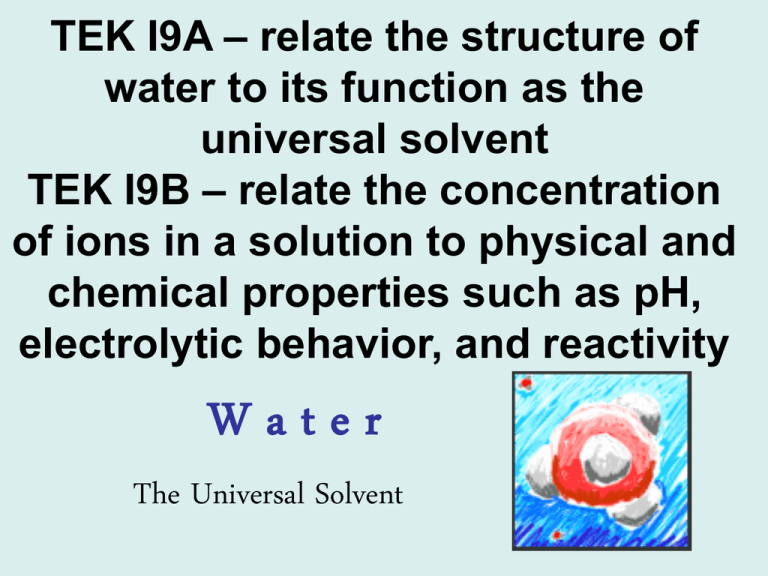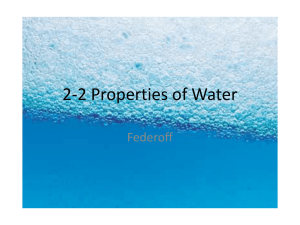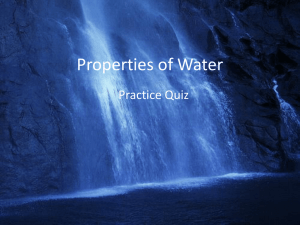W a t e r
advertisement

TEK I9A – relate the structure of water to its function as the universal solvent TEK I9B – relate the concentration of ions in a solution to physical and chemical properties such as pH, electrolytic behavior, and reactivity Water The Universal Solvent Water’s Importance • Water is called the "universal solvent" because it dissolves more substances than any other liquid. •A solution is made up of a solvent (the substance that does the dissolving) and a solute (the substance being dissolved). Water’s States • Water is unique in that it is the only natural substance that is found in all three states at the temperatures normally found on Earth. Liquid Solid (ice) Gas (steam) Day 3: #2 Phase Diagram of Water Triple Point Water is found on Earth in all three forms. This is because Earth is a very special planet with just the right range of temperatures and air pressures. Earth is said to be at the triple point for water. Day 3: #2 Water’s States Phase changes are physical changes – NOT chemical changes! Sample Question 1. The diagram shows physical changes that occur in the water cycle. Which of these shows condensation? a) Q b) R c) S d) T Day 3: #2 Answer Which of these shows condensation? d) T Clouds are water vapor that has condensed back into very small water droplets. Day 3: #2 Water's Structure • You probably know water's chemical description is H2O. One atom of oxygen is bound to two atoms of hydrogen. Water is a polar molecule. One side is positive and the other is negative. The hydrogen atoms are "attached" to one side of the oxygen atom, resulting in a water molecule having a positive charge on the side where the hydrogen atoms are and a negative charge on the other side, where the oxygen atom is. Day 3: #2 “Like Dissolves Like” •You need to know that polar substances, like water, dissolve other polar substances. •Nonpolar substances dissolve nonpolar substances •Put a nonpolar substance and a polar substance together and you will find that they don’t mix! Like oil and water. Very Important! Water is a polar molecule. One side is positive and the other is negative. Day 3: #2 Water's Polar Structure • Since opposite electrical charges attract, water molecules tend to attract each other, making water kind of "sticky." • The side with the hydrogen atoms (positive charge) attracts the oxygen side (negative charge) of a different water molecule. Day 3: #2 Sample Question 2. Which factor makes water an effective solvent? a) The presence of molecular oxygen b) Its lack of covalent bonds c) The polar nature of its molecules d) Its abundance on Earth’s surface Day 3: #2 Answer Which factor makes water an effective solvent? c) The polar nature of its molecules - Polar molecules and ions are attracted to the partial positive and negative charges within the water molecules. Day 3: #2 • Why is water used as a coolant in a car’s radiator? -because water holds a lot of heat! Instead of saying water can hold a lot of heat, in science we say that water has a high specific heat. Day 3: #2 How can some lizards and insects walk on water? The high surface tension of water allows them to walk across the water without breaking the surface! Day 3: #2 What is Surface Tension? • Surface tension is a measure of how difficult it is to stretch or break the surface of a liquid. • Water has a very high surface tension and can support some items that have higher densities, like the pin and insect shown to the left. Day 3: #2 Most solids are heavier than liquids. Then why does solid water (ice) float on liquid water? • Water is unusual in that the solid form, ice, is less dense than the liquid form, which is why ice floats. • Density of liquid water is 1g/mL Water’s Density • Implications… Lakes freeze from top to bottom and thus enables life to continue in the lake. If ice was more dense, ice would pack to bottom. Lakes might never completely thaw out and Earth’s climate would be much colder! Sample Question 3. Fish survive through severe winters because of the property of water that allows water to — a) form chemical bonds as it freezes, raising the water temperature below the ice b) increase in density while it freezes, dissolving more oxygen from the air c) expand when it freezes, creating a floating and insulating layer of ice d) precipitate vital nutrients when it freezes, increasing the food supply Day 3: #2 Answer Fish survive through severe winters because of the property of water that allows water to — c) expand when it freezes, creating a floating and insulating layer of ice - Ice is less dense than liquid water. The ice serves as an insulator for the liquid below. Day 3: #2 Sample Question 4. If the properties of water were to change so that the solid form was denser than the liquid form, organisms living in a cold pond environment would be less likely to survive because water would no longer — a) dissolve enough oxygen from the air b) produce solutions containing vital nutrients c) remain neutral, instead becoming highly acidic d) produce a floating insulating layer of ice Water is a Neutral Substance • Pure water has a neutral pH of 7, which is neither acidic nor basic. . Day 3: #3 What is Ph? • The “power of hydrogen” (pH) scale is from 1 to 14. • The pH shows whether a substance is acid (pH 1-6), neutral (pH 7) or basic (pH 8-14). Day 3: #3 What is pH? • That pH scale is actually a measure of the number of H+ ions in a solution. If there are a lot of H+ ions, the pH is very low. If there are a lot of OH- ions, that means the number of H+ ions is very low, so the pH is high. Day 3: #3 How is pH measured? • We can measure the pH by -dipping pH paper into the substance (shown to the right) -dipping litmus paper into the substance (if it turns blue it is a base) -using a pH meter to read the pH of the substance Day 3: #3 Sample Question 5. Citric fruits, such as oranges and grapefruit, contain citric acid, yet they are safe to eat. What is the approximate pH of citric fruit? A1 B5 C7 D 10 Day 3: #3 Sample Question Citric fruits, such as oranges and grapefruit, contain citric acid, yet they are safe to eat. What is the approximate pH of citric fruit? B5 -Citric fruits are acidic, so the pH must be less than 7. They are safe to eat, so they must not be that acidic Day 3: #3 Sample Question • 6. Two clear solutions are placed in separate beakers. The first solution has a pH of 4, and the pH of the second solution is unknown. If the two solutions are mixed and the resulting pH is 5, the second solution must have — A fewer suspended solids B a lower temperature C more dissolved salt (NaCl) particles D a higher concentration of OH– ions Day 3: #3 Answer • Two clear solutions are placed in separate beakers. The first solution has a pH of 4, and the pH of the second solution is unknown. If the two solutions are mixed and the resulting pH is 5, the second solution must have — D a higher concentration of OH– ions Day 3: #3 Electrolyte VS Nonelectrolyte An electrolyte is a substance that allows an electric current to pass through. The seawater in the beaker below is an example of an electrolyte (because the light bulb is glowing). When water contains dissolved ions or has dissolved a polar solute, then the solution will be electrolytic. Try this7. What characteristic of water remains the same no matter what is dissolved in it? A The ratio of hydrogen to oxygen B The ability to refract light C The hydroxide ion concentration D The freezing temperature 8. Bathwater normally has electrolytic behaviors even though distilled water does not. This is because bathwater (A) contains isotopes of hydrogen (B) has been heated (C) is separated into H+ and OH- ions (D) contains dissolved minerals 9. Which characteristic of water best explains its ability to dissolve a great variety of materials? (A) Its transparency in light (B) Its electrical conductivity (C) Its physical state of matter (D) Its molecular arrangement








